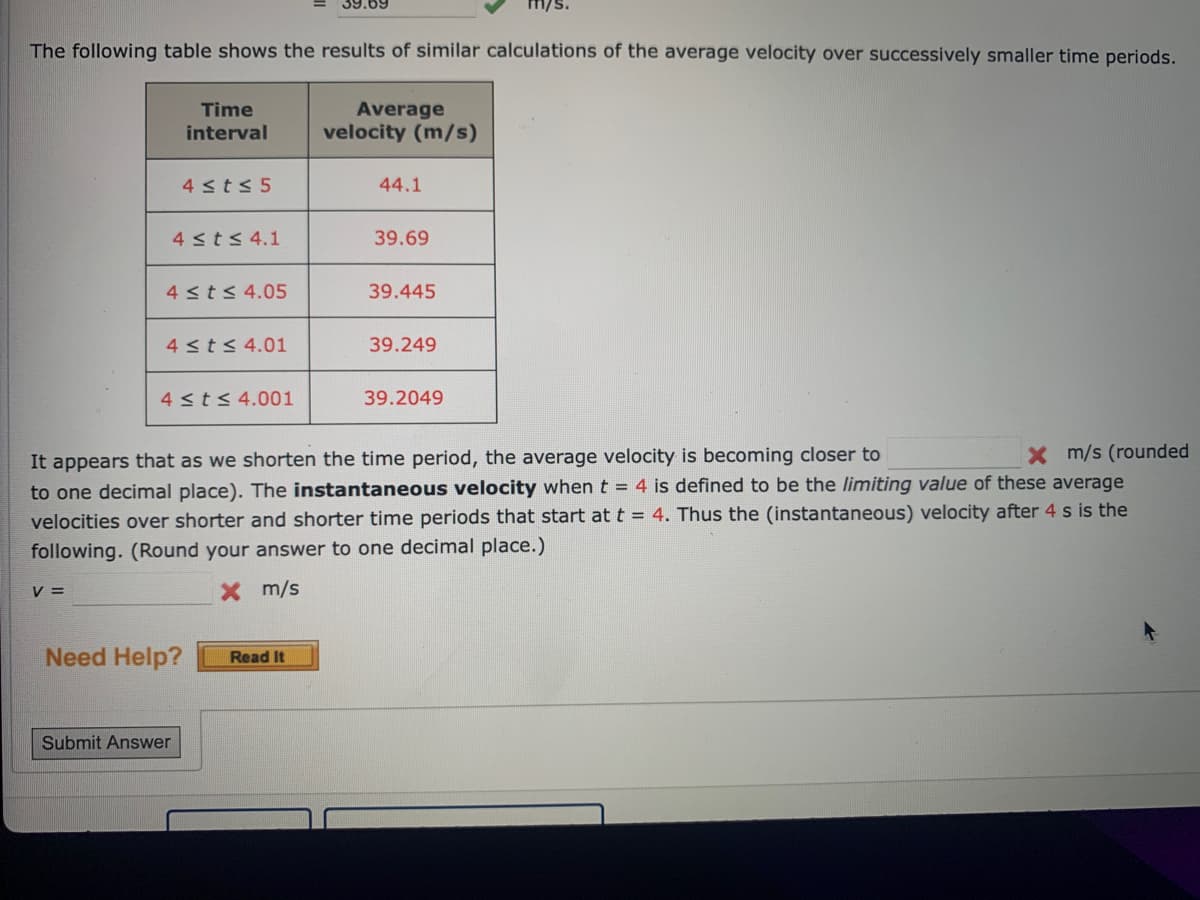The following table shows the results of similar calculations of the average velocity over successively smaller time periods. Average velocity (m/s) Time interval V = 4≤t≤5 4 ≤t≤ 4.1 4 ≤ t ≤ 4.05 4 ≤t≤ 4.01 4 ≤t≤ 4.001 44.1 39.69 39.445 39.249 39.2049 It appears that as we shorten the time period, the average velocity is becoming closer to X m/s (rounded to one decimal place). The instantaneous velocity when t = 4 is defined to be the limiting value of these average velocities over shorter and shorter time periods that start at t = 4. Thus the (instantaneous) velocity after 4 s is the following. (Round your answer to one decimal place.) X m/s
The following table shows the results of similar calculations of the average velocity over successively smaller time periods. Average velocity (m/s) Time interval V = 4≤t≤5 4 ≤t≤ 4.1 4 ≤ t ≤ 4.05 4 ≤t≤ 4.01 4 ≤t≤ 4.001 44.1 39.69 39.445 39.249 39.2049 It appears that as we shorten the time period, the average velocity is becoming closer to X m/s (rounded to one decimal place). The instantaneous velocity when t = 4 is defined to be the limiting value of these average velocities over shorter and shorter time periods that start at t = 4. Thus the (instantaneous) velocity after 4 s is the following. (Round your answer to one decimal place.) X m/s
Functions and Change: A Modeling Approach to College Algebra (MindTap Course List)
6th Edition
ISBN:9781337111348
Author:Bruce Crauder, Benny Evans, Alan Noell
Publisher:Bruce Crauder, Benny Evans, Alan Noell
Chapter1: Functions
Section1.2: Functions Given By Tables
Problem 2TU: Use the table of values you made in part 4 of the example to find the limiting value of the average...
Related questions
Question

Transcribed Image Text:The following table shows the results of similar calculations of the average velocity over successively smaller time periods.
V =
Time
interval
4≤t≤5
4 ≤t≤ 4.1
4 ≤t≤ 4.05
4 ≤t≤ 4.01
4 ≤t≤ 4.001
Submit Answer
Need Help?
Average
velocity (m/s)
Read It
44.1
39.69
39.445
It appears that as we shorten the time period, the average velocity is becoming closer to
X m/s (rounded
to one decimal place). The instantaneous velocity when t = 4 is defined to be the limiting value of these average
velocities over shorter and shorter time periods that start at t = 4. Thus the (instantaneous) velocity after 4 s is the
following. (Round your answer to one decimal place.)
X m/s
39.249
m/s.
39.2049
Expert Solution
This question has been solved!
Explore an expertly crafted, step-by-step solution for a thorough understanding of key concepts.
This is a popular solution!
Trending now
This is a popular solution!
Step by step
Solved in 2 steps with 1 images

Recommended textbooks for you

Functions and Change: A Modeling Approach to Coll…
Algebra
ISBN:
9781337111348
Author:
Bruce Crauder, Benny Evans, Alan Noell
Publisher:
Cengage Learning

Functions and Change: A Modeling Approach to Coll…
Algebra
ISBN:
9781337111348
Author:
Bruce Crauder, Benny Evans, Alan Noell
Publisher:
Cengage Learning